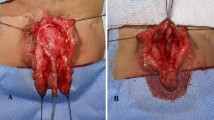Abstract
Objective
The objectives of surgical repair of epispadias include the achievement of urinary continence, cosmetically acceptable genitalia with correction of curvature and normal genital function. To achieve all the aforementioned objectives, patients usually undergo two- or multiple-stage surgeries. Traditionally, the patients undergo epispadias repair in the first stage through modified Cantwell–Ransley or Mitchell–Bagli procedure. Subsequently, in the second stage, bladder neck repair is performed to achieve continence, the most common procedure being modified Young-Dees–Leadbetter. There is no reported single-stage technique of epispadias repair achieving both cosmesis and continence in isolated incontinent epispadias. The objectives of the study were to assess continence and cosmesis with partial penile disassemble and double breasting of bladder neck and posterior urethra in isolated peno-pubic epispadias.
Materials and methods
A retrospective analysis of surgical outcome of seven cases of primary isolated incontinent peno-pubic epispadias repair from July 2008 to July 2012 was carried out. Patients’ age varied from 10 months to 16 years. Penile de-gloving is done with mobilization of urethral plate from ventrum to dorsum, distally till mid-glans and proximally up to pubic symphysis with preservation of blood supply at both ends. Partial mobilization of corporal bodies from its attachment and division of peno-pubic ligament are done to lengthen the penis. A mucosal strip of 5–7 mm is excised to denude the mucosa for double breasting. Tubularization of urethral plate with double breasting from the region of bladder neck to posterior urethra is done to increase the outlet resistance and then tubularization of distal urethral plate. Approximation of mobilized pelvic floor muscles is done to complete sphincteroplasty. Spongioplasty along the entire length and corporoplasty with medial rotation of corporeal bodies is done. Glanuloplasty with meatoplasty is done to bring the meatus ventrally and then skin cover to penis is done with rotation of ventral flaps or z plasty.
Results
Preoperatively, three patients (42.8 %) had moderate and four (58.2 %) had severe chordee. Three (42.8 %) of the seven patients had mild torque toward right. Six patients became fully continent and had excellent cosmesis postoperatively, while one was partially continent with a dry interval of 2 h and required anticholinergics. None of the patients developed fistula, stricture, wound dehiscence or necrosis in a follow-up period of 1–5 years; however, one patient had mild residual chordee but did not require any additional surgery.
Conclusion
Double breasting of bladder neck and posterior urethra with sphincteroplasty and partial penile disassembly produces a reliable tubularized neourethra with complete chordee correction with emphasis on achievement of continence and near-normal-appearing penile morphology through a single-stage surgery. Mobilization of urethral plate and proximal urethra up to bladder neck helps correction of chordee as well as torsion. Partial penile disassembly kee** the urethra attached to glans maintains the dual blood supply, thus preventing stricture and fistula. This small series is a preliminary study, and more studies at different centers may authenticate it by reproducing the results.





Similar content being viewed by others
References
Lascaratos J, Poulakou-Rembelakou E, Rembelakos A, Marketos S (1995) The first case of epispadias: an unknown disease of the Byzantine Emperor Heraclius (610–641 AD). Br J Urol 76:380–383
Gearhart JP, Mathews RI (2007) Exstrophy-epispadias complex. In: Wein AJ (ed) Campbell-Walsh urology, 10th edn. Saunders Elsevier, Philadelphia, p 3325
Ransley PG, Duffy PG (1995) Bladder exstrophy closure and epispadias repair. In: Spitz L, Coran AG (eds) Rob & Smith operative surgery (pediatric surgery). Chapman & Hall, London, pp 745–759
Mitchell ME, Bagli DJ (1996) Complete penile disassembly for epispadias repair: the Mitchell technique. J Urol 155:303–304
Koff SA, Eakins M (1984) The treatment of penile chordee using corporeal rotation. J Urol 131:931
Dees JE (1949) Congenital epispadias with incontinence. J Urol 62:513
Kramer SA, Kelalis PP (1982) Assessment of urinary continence in epispadias: review of 94 patients. J Urol 128:290
Mollard P, Basset T, Mure PY (1998) Male epispadias: experience with 45 cases. J Urol 160:55
Mouriquand PD, Bubanj T, Feyaerts M, Jandric M, Timsit M, Mollard P et al (2003) Long-term results of bladder neck reconstruction for incontinence in children with classical bladder exstrophy or incontinent epispadias. Br J Urol Int 92:997
Hafez AT, Helmy T (2011) Complete penile disassembly for epispadias repair in postpubertal patients. Urology 78:1407–1410
Hammouda HM (2003) Results of complete penile disassembly for epispadias repair in 42 patients. J Urol 170:1963–1965
Surer Ilhami, Baker LA, Jeffs RD, Gearhart JP (2001) Modified Young-Dees–Leadbetter bladder neck reconstruction in patients with successful primary bladder closure elsewhere. J Urol 165:2438–2440
Gearhart JP, Yang A, Leonard MP, Jeffs RD, Zerhouni EA (1993) Prostate size and configuration in adults with bladder exstrophy. J Urol 149(2):308–310
Perovic SA, Vukadinovic V, Djordjevic ML, Djakovic NG (1999) Penile disassembly technique for epispadias repair: variants of technique. J Urol 162:1181–1184
Mokhless I, Youssif M, Ismail HR, Higazy H (2008) Partial penile disassembly for isolated epispadias repair. Urology 71:235–238
Pippi Salle JL, Jednak R, Capolicchio JP, França IMP, Labbie A, Gosalbez R (2002) A ventral rotational skin flap to improve cosmesis and avoid chordee recurrence in epispadias repair. Br J Urol Int 90:918–923
Surer I, Baker LA, Jeffs RD, Gearhart JP (2000) The modified Cantwell–Ransley repair for exstrophy and epispadias: 10 year experience. J Urol 164:1040–1043
Sarin YK, Manchanda V (2006) Mitchell’s technique for epispadias repair: our preliminary experience. J Indian Assoc Pediatr Surg 11:31–34
Conflict of interest
None.
Author information
Authors and Affiliations
Corresponding author
Rights and permissions
About this article
Cite this article
Bhat, A., Upadhayay, R., Bhat, M. et al. Double breasting of bladder neck and posterior urethra for continence in isolated peno-pubic epispadias. Int Urol Nephrol 47, 789–795 (2015). https://doi.org/10.1007/s11255-015-0947-7
Received:
Accepted:
Published:
Issue Date:
DOI: https://doi.org/10.1007/s11255-015-0947-7




